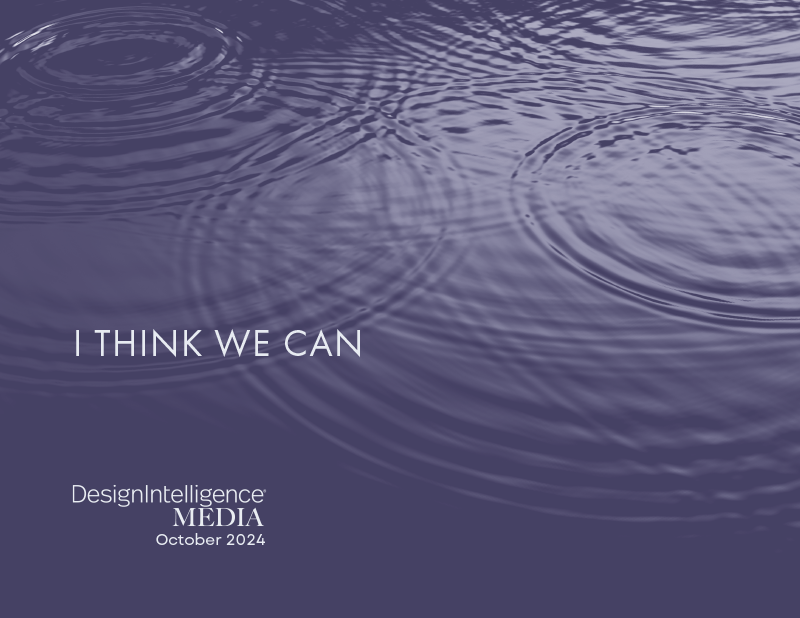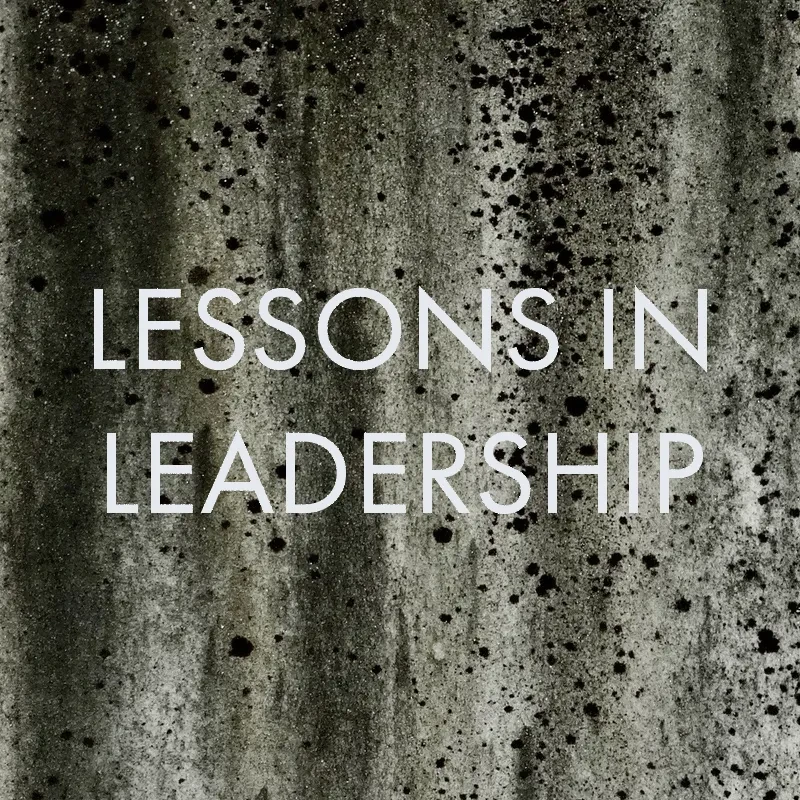
I Think We Can
Michael LeFevre
Managing Editor, DesignIntelligence
October 9, 2024
Thoughts on seeking questions, decisions and their consequences.
Just a Few
As I reflect, I’ve only made a handful of significant, conscious, major decisions over the course of my life. Amazingly, each worked out for the best. All of which prompts the questions: Perhaps I should have made more decisions? Perhaps I should have asked more questions?
These personal decisions include choices such as getting married, moving to a new city and changing jobs. Even changing careers once. Certainly, having a daughter ranks near the top of the list. On the professional front, a handful of key decisions about projects, people and paths were important in retrospect.
There are many accounts of successful entrepreneurs and businesspeople who have risen to the top only to fail miserably. These self-starters and business builders are noteworthy for their often-priceless experience with the volatile, cyclical nature of success.
In contrast, I’ve had no major failures as measured by financial or personal outcomes. Why? Because I’ve chosen not to take the big risks. They didn’t suit my personal risk profile. While I may have had ideas and inclinations to do so, I’ve never created a company or put my family’s fortune at risk by starting a new venture. I’ve always preferred to work as part of a team and within an established organization that ran the business to guarantee a relatively predictable income for all of us. For me, this was the best path to allow my creativity to flourish and for smaller, calculated risks to be bracketed, supported and protected by the organization’s system of checks and balances and diverse offerings. Along the way, I was honest in assessing my ability to make good decisions and, after seeing my true capabilities in this area, sought to improve by almost any means necessary.
But having had the success I enjoyed as a result of my major decisions, I’ve often wondered: Where would I be, had I taken more (or bigger) shots? Or asked different questions? I guess I’ll never know, because we can’t go back. But we can continue to be students of the question-posing and decision making game and continue to learn and explore. In this essay, I’ll attempt just that and share it with you.
Now and Then
Why a deep dive into consequential questions and the decisions that follow? Why now? Simply because the impact of our decisions as leaders of the built environment has never been greater. And the questions that precede these decisions are even more impactful. Converging social, environmental, economic and physical responsibilities now conspire to connect our built environment in new and more significant ways for us all. We have transcended the specter of designing stand-alone projects while mindless of their connections to larger contexts and systems. In matters of design, we’re taught there is no correct answer. But now that the stakes are higher than mere art, architecture and buildings, many of our answers and solutions carry much greater weight or impact than others. They are more correct, or at least, more important.
As leaders, we are negligent when we ignore our broader duties. And how best to learn in such a critical time? By looking to the best! The need for us to look beyond our own profession and learn from the best is immediate and immense. As we have done for all the 30 years of DesignIntelligence and the Design Futures Council, we look not only to our own industry’s elite, but also beyond that to the best of the best in all disciplines. Let’s begin.
Be Prolific
Paraphrasing Nobel Laureate Linus Pauling: To have good ideas, have lots of ideas. Synthesizing Michael Jordan’s advice: To be ready to make the big (or right) decision when the time comes, you need to have taken thousands of practice shots (decisions, in our case) in preparation. You must be ready — mentally, having visualized the scenario, and physically, through hard work and discipline — when the opportunity (to ask the right question) presents itself.
Know Yourself and Others
The experts tell us that to become better thinkers and chart better paths, we must begin by knowing ourselves. They suggest we look to those we admire as role models and extract and emulate the traits they exhibit. To appeal to a broader readership, I’ll stretch myself beyond my familiar, comfortable favorites in these categories (typically exemplars that were humble and politically aligned with my own views) and consciously include some more controversial examples for the sake of an expanded demographic and to stretch our collective learning curves. To listen, look and maybe even learn from the perspectives and processes of others who may not be like us. No pain, no gain, it is said.
I have a similar dream on a much more modest scale, a dream that all design professionals can rebuild their thought processes, values and decision making skills to regain the respect we believe we deserve. That we can learn to ask the right questions and grow in our critical thinking skills.
Only by will, determination and a plan of action to change will we achieve that dream.
Can We Learn from the Best?
To learn from the experiences of other experts, let’s look at some classic examples of the decision process. Each begins with the ability to seek and find the right question. To better understand, let’s draw from a few exemplars typically seen as being good, or even simply illustrative or informative, at question framing and decision making.
Classic Case Studies
The Cuban Missile Crisis
Chronicled in books and film, President John F. Kennedy’s handling of the Cuban Missile Crisis in October 1962 is universally heralded as a
fine example of keeping cool under pressure. Not just any pressure: The fate of the world hung in the balance and Nuclear War was a strong
possibility. With Communist missiles aimed at U.S. shore and pressure mounting, JFK was able to keep his head and succeed as a leader. How
did he do it? By relying on a diverse team of experts, by availing himself of all the intelligence he could, asking the most important
questions and in his final, confident act, by calling his opponent’s bluff. Faced with world-changing stakes, even the Communists would come
to their senses, JFK reasoned. And they did.
Abraham Lincoln
During his presidency, Lincoln met regularly with cabinet members and advisers to elicit their opinions and gather information before making
decisions. To broaden his perspective, in a forbear to current social media and opinion polling, he sought the opinions of ordinary citizens
and invited them to the White House to share their views. Genius! What a fine way to capture the pulse of popular sentiment: Ask them. In
retrospect, he likely leveraged these tactics to inform what is popularly termed Lincoln’s Decision: On January 1, 1863, he issued the
Emancipation Proclamation that freed the slaves within the Confederacy.
Warren Buffett
How does Berkshire Hathaway’s investment guru ply his trade? One thing is for sure: He takes the long view. By considering distant horizons,
he is able to see and think clearly and manage market volatility. By constantly asking what if, he avoids the black swan fallacy of
extrapolation and prepares for unpredictable outcomes. His hedge is to manage a diverse portfolio, keeping his options open and in multiple
baskets. Those strategies, coupled with operating with a great team, with the best tools and from a position of abundance, serve him well in
pursuit of financial returns.
New Role Models?
These classic cases serve well, but can we benefit from any newer examples from women leaders or in the context of social media and the era of disinformation? We can.
Caitlin Clark
Since joining the WNBA in recent weeks, basketball star Caitlin Clark has faced the harsh realities of her entry into the league. Now, under
the intense scrutiny of the public eye and the fierce competition of many battle-scarred veteran competitors, she has faced egregious fouls,
hard hits and tough times. Her recent postgame reaction to a flagrant foul committed against her?
“Yeah, I wasn’t expecting that. But it’s just ‘Respond, calm down and let your play do the talking.’”
She asked herself: What good will come of complaining. A second example is her reaction to being snubbed for the U.S. Olympic team: “I’m excited for the girls that are on the team,” she shared. Emotionally mature, intelligent responses to be sure. And good decisions, compared to the alternatives of starting an on-court and/or social media-based feud with the offending opponent and snubbing committee.
Benchmarking: An Honest Assessment
As question framers, decision makers and leaders in the built environment industry, how do we compare against these greats from the fields of politics, geopolitical warfare, business and sports? In most cases, not very well, I’m afraid. Why not?
My thoughts go immediately to our training and culture. In design schools, at least, we are trained and rewarded to diverge, play and push the envelope of risk. Such is the process by which great design is realized. Counterintuition, changing scales and the intentional inefficiency of going in circles and looking backward are de rigueur in design decision making. While we are taught in programming classes to “ask the right questions,” little, if any, discussion is given in architecture school to learning how to managing risk or making good, efficient or “correct” decisions.
Contrast that culture with the curricula and student mentalities seen in construction schools, business schools, medicine (e.g., triaging) and almost all non-design disciplines. Assessing and managing priorities and allocating and reducing risk are not just more valued than they are in design, they are predominant. The “main” thing, or the “only” thing, if you will. Everything else is a distant second in the non-design disciplines.
Need convincing? Design projects in firms across the country are replete with countless examples of staff architects working into the night studying handrail design options while their project is wildly over budget. Such actions threaten project viability rather than working to rebalance their designs within their budgets. No matter how you look at it, that’s bad decision making. Perhaps by the project manager who assigned the task, or the individual who irresponsibly fritters away their scarce time (and the firm’s fee) on doing the wrong thing at the wrong time. It’s the equivalent of rearranging the deck chairs on the Titanic — a classic sign of misdirected, aberrant decision making and a clear failure to ask the right questions.
All this despite our often-misguided self-confidence as leaders and choreographers of large, collaborative design teams. Too often, our self-praise and that of our design instructors seems more akin to the proverbial “participation trophies” given to our children playing soccer and little league. We declare ourselves to be lucid thinkers and believe it to be so. It is only when we are put to the test in project applications that our lacking skills become manifest: Over budget! Late documents! At these too-frequent junctures, we are then forced to rely on our more skilled teammates such as construction managers, trade contractors and owners to supply the clarity of thought and emotional intelligence we need to regain balance. Those of us who bemoan the greater incomes of our partners need only look to their question framing and risk management skills — and their commensurate value and rewards in the marketplace — for the answers.
Hope Abides
My ranting (or is it simply stating the necessary truth?) aside, what can we do as professionals to become better at decision making? How can we effect a value shift so we can more closely align with those of our clients and partners — without throwing in the towel on excellent design and the growing number converging forces we now must accommodate? Here are a few suggestions.
Practice
As in the old saw about how you get to Carnegie Hall, simply acknowledging and working at the discipline of making decisions offers much.
Practice, practice, practice. With time and commitment, you’ll improve. We do it every day, but do we do it with rigor and emotional
intelligence?
Science and Discipline
Like most things we do in a civilized world, decision making is now a science. Study its principles and lessons. Study and learn from the
greats. Borrow, steal, adapt and internalize the great strategies from other disciplines and use them for good in architecture. Be smart.
Use the best tools available to support, document and enable decision making. AI is here. Embrace it. We’ll still need you for the final
curation, judgments and decisions, but perhaps we can let machines carry some of the load.
Diversity and Expertise
Rather than continuing to associate with sloppy, undisciplined thinkers, find a new team. Build it yourself. Construct a team with shared
values that exudes positive decision vibes and cares about its outcomes rather than maintaining an attitude of skeptical recalcitrance and
exhibiting “energy vampire” aspirations. Bring new, diverse skills, experience sets, backgrounds and people types into your processes.
You’ll be better for it.
Have a Dream
I recently visited Memphis, Tennessee, a city famous for its barbeque and blues. But our stop at the Lorraine Motel — the scene of Martin
Luther King Jr.’s 1968 assassination — was most moving. In his legendary I Have a Dream speech delivered in Washington, D.C., on August 28,
1963, Dr. King spoke of civil rights and a future in which all mankind could be created equal.
I have a similar dream on a much more modest scale, a dream that all design professionals can rebuild their thought processes, values and decision making skills to regain the respect we believe we deserve. That we can learn to ask the right questions and grow in our critical thinking skills.
Only by will, determination and a plan of action to change will we achieve that dream.
I hope we do. I think we can.
Michael LeFevre, FAIA emeritus, is managing editor of DesignIntelligence, senior fellow in the Design Futures Council and author of “Managing Design” (Wiley 2019), an Amazon #1 bestselling new release.







